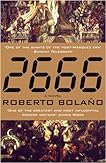Full 2666 review
 2666 by Roberto Bolaño
2666 by Roberto BolañoMy review
According to Reiter, the main character in Book Five, the last book, “Semblance was an occupying force of reality”. This is how a reader should approach Bolaño’s immense 2666, which comprises five books in all. As with the faux reality in most writings, from literary to chick lit, to crime, for instance, the reader expects to read dialogue that is encompassed between quotation marks, double in American books, single in British ones. However, with 2666, be ready to suspend your usual view on how good writing should look like.
2666 is actually translated by an American. So, do not question the spelling, of words like colour as color, and of punctuations like double quotation marks, in this British edition. Moreover, when you read up to Book Four (if you intend to begin your reading journey from Book One, instead of randomly) the part about the crimes, you won’t find a single, nor even double quotes, anywhere in the conversations. Bolaño’s unusual stratagem actually works here. The upshot of this is immediacy. The reader gets directly into the mind of the characters talking to one another, as if you yourself have taken on their roles – you have become their semblance.
Yet another stratagem is paragraph manipulation. And, with this, I’m not talking about the normally recommended device of cutting long paragraphs into shorter ones. In most writings, the writer (or his editor) would divvy up any lengthy paragraph and make smaller ones, for easier reading. But no, in the same Book Four, you would be hard pressed to find such paragraphing. Instead, you’d come across pages and pages of long, huge, blocks of writing not relieved by breakage. Better still (or, is it, worse still, for some?) in Book One, you’d read, sometimes, for two to three pages, of just one sentence. The strange thing here is, it works, so perfectly, that astoundingly the reader does not get lost in the long train of words, nor get derailed grammatically.
Most of Bolaño’s characters in this tome are displaced personalities. The critics in Book One are constantly flying around the world, attending conferences, researching a German writer, Archimboldi, their sole obsession. In Book Two, Amalfitano is Chilean (like Bolaño) but lives in Mexico, in a small border city of St Teresa. Like the critics before him, he travels to and from South America and Europe. His daughter Rosa gets to go through airport customs via the EU gate while he is relegated to the non-EU one. In Book Three, a black American reporter Fate is sent to Mexico to cover a boxing match, meant for the sports writer, who died. Book Four is all about displaced Mexican women who have to leave their villages to work in the city, and most get murdered there. Finally, in Book Five, Reiter has to fight a war away from German, in Russia.
Of the violence in the books, certainly the Mexican women are the ones directly affected by it. But all the other characters, too, have some involvement in violence, no matter how removed. The reader meets his first intimation of unthinking violence in Book One, when the critics beat up their London taxi driver and derive pleasure akin to orgasm. In Book Two and Three Amalfitano’s daughter has to be spirited out of Mexico by Fate when she is in danger from her lover. Book Four, of course, is steeped in violence. So many women are raped, tortured and murdered, that the telling of their stories is depicted as if lifted directly from police reports. Each incident is told in unemotional, detached reportage, beginning with where and how the victim is found, and then the coroner’s verdict in gross detail, and finally her body is unceremoniously dumped in an unmarked burial ground.
Of all Bolaño’s characters in this novel, the most rounded is Archimboldi. In Book One he is the writer whom the critics are looking for in Mexico. In Book Five, predictably, the longest of the five novellas, Archimboldi is fully fleshed out. But before his introduction to the reader, the manner in which he is told that his mother had one eye and his father one leg only is almost fairy tale-like, albeit darkly: “His mother was blind in one eye.” But this fairy tale goes up in smoke as soon as we find out more about Archimboldi, or Reiter, his real name, and his predilection for holding his breath under water. Reiter is suicidal, rushing ahead of flying bullets.
The ugly violence of the killings aside, Bolaño’s final novel before his own death is a surprisingly easy read for this reviewer, even with the occasional three to five pages of a single continuous sentence. Whether you are averse to long syntactic constructions or simply accept them, you have to view them, or the whole work, just as a character in it views an Arcimboldo painting: get differing perspectives from the same painting depending on how one angles it.
Don’t be put off by any of this, or by the sheer number of pages to get through, a little below 900 pages. Trust me, you’ll surprise yourself with how easily and quickly you’ll flip the pages in anticipation - you’d be having a gripping good read throughout. Also, you are getting five books in one package, at a one-book price.
--
An edited version appeared in the Malaysian Sunday Star paper on June 28 2009.
View all my reviews.





















